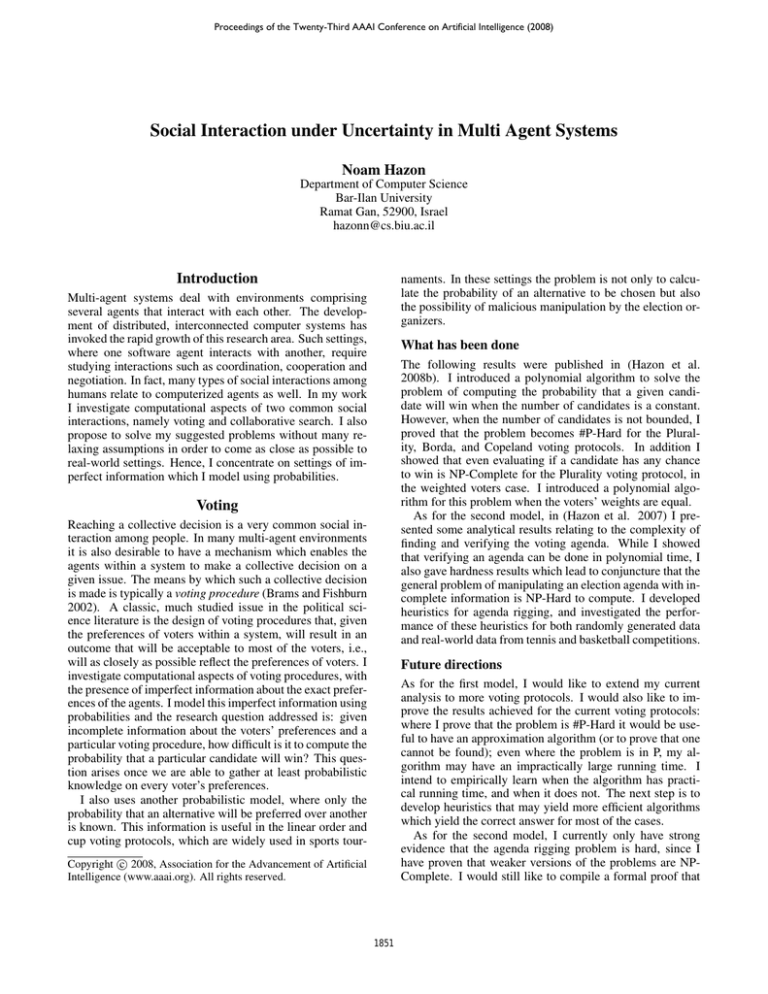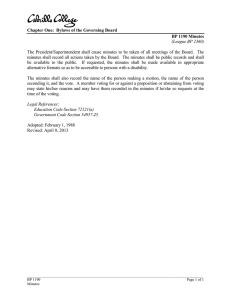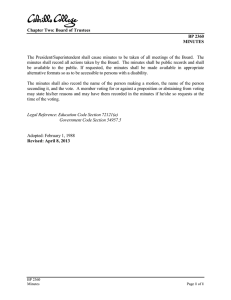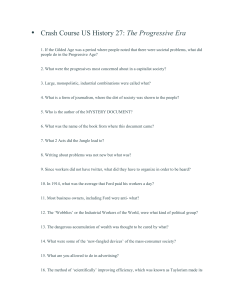
Proceedings of the Twenty-Third AAAI Conference on Artificial Intelligence (2008)
Social Interaction under Uncertainty in Multi Agent Systems
Noam Hazon
Department of Computer Science
Bar-Ilan University
Ramat Gan, 52900, Israel
hazonn@cs.biu.ac.il
Introduction
naments. In these settings the problem is not only to calculate the probability of an alternative to be chosen but also
the possibility of malicious manipulation by the election organizers.
Multi-agent systems deal with environments comprising
several agents that interact with each other. The development of distributed, interconnected computer systems has
invoked the rapid growth of this research area. Such settings,
where one software agent interacts with another, require
studying interactions such as coordination, cooperation and
negotiation. In fact, many types of social interactions among
humans relate to computerized agents as well. In my work
I investigate computational aspects of two common social
interactions, namely voting and collaborative search. I also
propose to solve my suggested problems without many relaxing assumptions in order to come as close as possible to
real-world settings. Hence, I concentrate on settings of imperfect information which I model using probabilities.
What has been done
The following results were published in (Hazon et al.
2008b). I introduced a polynomial algorithm to solve the
problem of computing the probability that a given candidate will win when the number of candidates is a constant.
However, when the number of candidates is not bounded, I
proved that the problem becomes #P-Hard for the Plurality, Borda, and Copeland voting protocols. In addition I
showed that even evaluating if a candidate has any chance
to win is NP-Complete for the Plurality voting protocol, in
the weighted voters case. I introduced a polynomial algorithm for this problem when the voters’ weights are equal.
As for the second model, in (Hazon et al. 2007) I presented some analytical results relating to the complexity of
finding and verifying the voting agenda. While I showed
that verifying an agenda can be done in polynomial time, I
also gave hardness results which lead to conjuncture that the
general problem of manipulating an election agenda with incomplete information is NP-Hard to compute. I developed
heuristics for agenda rigging, and investigated the performance of these heuristics for both randomly generated data
and real-world data from tennis and basketball competitions.
Voting
Reaching a collective decision is a very common social interaction among people. In many multi-agent environments
it is also desirable to have a mechanism which enables the
agents within a system to make a collective decision on a
given issue. The means by which such a collective decision
is made is typically a voting procedure (Brams and Fishburn
2002). A classic, much studied issue in the political science literature is the design of voting procedures that, given
the preferences of voters within a system, will result in an
outcome that will be acceptable to most of the voters, i.e.,
will as closely as possible reflect the preferences of voters. I
investigate computational aspects of voting procedures, with
the presence of imperfect information about the exact preferences of the agents. I model this imperfect information using
probabilities and the research question addressed is: given
incomplete information about the voters’ preferences and a
particular voting procedure, how difficult is it to compute the
probability that a particular candidate will win? This question arises once we are able to gather at least probabilistic
knowledge on every voter’s preferences.
I also uses another probabilistic model, where only the
probability that an alternative will be preferred over another
is known. This information is useful in the linear order and
cup voting protocols, which are widely used in sports tour-
Future directions
As for the first model, I would like to extend my current
analysis to more voting protocols. I would also like to improve the results achieved for the current voting protocols:
where I prove that the problem is #P-Hard it would be useful to have an approximation algorithm (or to prove that one
cannot be found); even where the problem is in P, my algorithm may have an impractically large running time. I
intend to empirically learn when the algorithm has practical running time, and when it does not. The next step is to
develop heuristics that may yield more efficient algorithms
which yield the correct answer for most of the cases.
As for the second model, I currently only have strong
evidence that the agenda rigging problem is hard, since I
have proven that weaker versions of the problems are NPComplete. I would still like to compile a formal proof that
c 2008, Association for the Advancement of Artificial
Copyright °
Intelligence (www.aaai.org). All rights reserved.
1851
I showed the other two problems (Min-Budget and Maxprobability) to be NP-complete even for the path setting.
Thus, I considered further restrictions and also provided an
approximation scheme. I showed that both problems are
polynomial if the number of possible prices is constant. For
the Min-Budget problem, I also provided an FPTAS approximation scheme, such that for any ² > 0, providing a (1 + ²)
approximation in time O(poly(n²−1 )).
For the multi-agent case, I showed that if the number of
agents is fixed, then all of the single-agent algorithms extend
to k-agents, with the time bounds growing exponentially in
k. Therefore the computation of the agents’ strategies can be
performed whenever the number of agents is relatively moderate, a scenario characterizing most physical environments
where several agents cooperate in exploration and search. If
the number of agents is part of the input then Min-Budget
and Max-Probability are NP-complete even on the path and
even with a single price.
the original problem of agenda rigging is NP-Complete. Another possible direction is to test my manipulation agenda
problem under restricted settings, such as a fixed number of
voter types.
Collaborative search
Frequently, in order to successfully complete their task, a
team of agents may need to explore (i.e., search) their environment and choose among different available options. For
example, a team of agents seeking to purchase a product
over the internet needs to query several electronic merchants
in order to learn their posted prices; a team of robots searching for a resource or a tangible item needs to travel to possible locations where the resource is available and learn the
configuration in which it is available as well as the difficulty
of obtaining it there. In these environments, the benefit associated with an opportunity is revealed only upon observing it. The only knowledge available to each agent prior to
observing the opportunity is the probability associated with
each possible benefit value of each prospect.
While the exploration in virtual environments can sometimes be considered costless, in physical environments traveling and observing typically also entails a cost. Furthermore, as any agent travels to a new location its cost of exploring other unexplored locations changes. For example,
consider a team of Rover robots with the goal of mining a
certain mineral. Potential mining locations may be identified based on a satellite image, each associated with some
uncertainty regarding the difficulty of mining there. In order
to assess the amount of battery power required for mining at
a specific location, a robot needs to physically visit there. A
robot’s battery is thus used not only for mining the mineral
but also for traveling from one potential location to another.
My research problem is to find optimal strategies for a team
of agents acting in such physical environments.
I consider three variants of the problem, differing in their
objective. The first, Min-Expected-Cost, is the problem of
a group of agents that aims to minimize the expected total
cost of completing their task. The second, Max-Probability,
considers a team of agents that is given an initial budget for
the task (which it cannot exceed) and needs to act in a way
that maximizes the probability it will complete the task (e.g.,
reach at least one opportunity with a budget large enough
to successfully buy the product). In the last variant, MinBudget, the agents are requested to guarantee a pre-defined
probability of completing the task, and they need to minimize the overall budget that will be required to achieve the
said success probability.
Future directions
First, I would like to complete the theoretical analysis in order to find an efficient approximation for the Min-ExpectedCost and Max-probability problems, or to prove they can not
be approximated within a constant factor. After laying the
theoretical foundations for the problem, the next step to consider is to extend the multi-agent models to scenarios where
each agent operates with a private budget, for example, multiple Rovers, each equipped with a battery of its own. In
this model a possible policy would be to send one robot on
an exploration, and to use another one to perform the task.
Therefore, this model incorporates the problem of collaboration among a team of agents in the presence of uncertainty,
which has not been sufficiently investigated. I also plan to
develop heuristics for the general metric space case (which
I proved to be NP-hard) and to empirically test them.
Acknowledgment
My work is conducted under the helpful guidance of Prof.
Sarit Kraus from the Computer Science Department at BarIlan University, Israel.
References
Brams, S. J., and Fishburn, P. C. 2002. Voting procedures. In Arrow, K. J.; Sen, A. K.; and Suzumura, K., eds.,
Handbook of Social Choice and Welfare. Amsterdam, The
Netherlands: Elsevier Science Publishers.
Hazon, N.; Dunne, P. E.; Kraus, S.; and Wooldridge, M.
2007. How to rig elections and competitions. In The 9th
Bar-Ilan Symposium on the Foundations of Artificial Intelligence (BISFAI-2007).
Hazon, N.; Aumann, Y.; Kraus, S.; and Wooldridge,
M. 2008a. Physical search problems applying economic
search models. In The Twenty-Third Conference on Artificial Intelligence (AAAI-08).
Hazon, N.; Aumann, Y.; Sarne, D.; and Kraus, S. 2008b.
Evaluation of election outcomes under uncertainty. In The
Seventh International Conference on Autonomous Agents
and Multiagent Systems (AAMAS-08).
What has been done
The following results will be published in (Hazon et al.
2008a). I first considered the single agent case and proved
that in general metric spaces all three problem variants are
NP-hard. Thus, I focused on the case where the opportunities are aligned along a path (either closed or a nonclosed one) and the cost of observing the true value of any
unexplored source depends on its distance (along the path)
from the agent’s current position. For this case I provided a
polynomial algorithm for the Min-Expected-Cost problem.
1852






